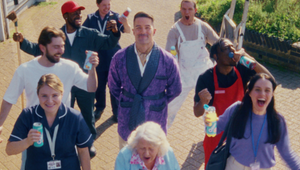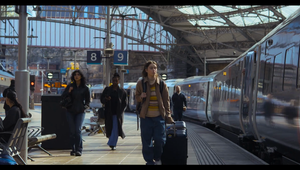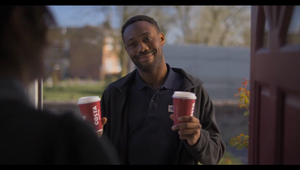
Behind WPP and Hogarth's Major New Virtual Production Push

Virtual production has reached a tipping point as the world’s biggest advertising holding company enters the race. WPP and its worldwide creative production network, Hogarth Worldwide, has announced a new partnership with virtual production specialists Final Pixel, launching a large-scale offering for clients around the world. That news follows last week’s revelation that FMCG company Reckitt is planning to put 80% of its production through virtual production, indicating a substantial shift as brands and advertising companies are taking the new tech seriously and implement it at scale.
Hogarth Final Pixel, the new offering, will also see Hogarth add virtual production LED stages to its content capture facilities. Hogarth already operates 120,000 square feet of capture space across 22 markets, and virtual 'volume' stages will soon start popping up across key locations, starting with Sydney, New York and London.
According to Penri Jones, Hogarth’s global chief production and innovation officer, it is important to provide physical virtual production facilities, such as the distinctive LED volume stages, as well as production expertise, in order to provide a seamless production ecosystem.
“We increasingly believe in an end-to-end solution for clients. I think given the disruption this technology brings, it’s critically important to the point around the pipeline and level of specialism involved. Everything starts to move from post, and that’s where the pre-visual side and the asset creation really comes to life,” he says.
“I think that’s when the story starts to make sense at scale, including capture networks as in shoot stages and LED stages, where we can take the brands on that journey from strategy, creative, the previsualisation through to the pipeline on set. But more importantly, how do we then amplify and execute that across all markets, across every language as well, and using the same assets and the same workflow? That’s where we see the real opportunity to drive this value.”
Given the relative novelty of the virtual production technology and the changes to the traditional production workflow, the team at Hogarth know that there is a big consultation and education task ahead in order to ensure that teams are brought up to speed with new pipelines and the insights and lessons learned to date.
With that in mind, Hogarth has partnered with Final Pixel, a creative production studio with an expertise in virtual production and experience in providing virtual production training. According to Monica Hinden, partner and executive producer with Final Pixel, it’s vital to make sure that producers are properly supported while also protecting clients’ budgets.
“It’s that fear of ‘how do I manage this thing from start to finish?’ We have a consulting pipeline, we take the producers through on their first, second, or third - depending on their comfort level and how different each project is. We have a full consulting process that we attach to any big project that we’re working with so that they can learn the steps and it’s not just throwing them in,” shares Monica.
“That’s really what we’ve focused on the last couple of years,” Monica says. “That pipeline is not just about enabling execution, but enabling a seamless process. When there’s new technology on the table, there’s so much testing and learning - and that’s fantastic - but when you have an actual project with an actual client with a legitimate budget, you need to have all your I’s dotted and your T’s crossed. You need to be buttoned up and ready to go in the morning of that shift. And that’s what we bring to the table. We can’t have four hours of down time, therefore that’s part of our education process and our consulting. In this world, time is money, especially on an advertising shoot.”
Final Pixel is run by CEO Michael McKenna, EP Monica Hinden and director/partner Christopher McKenna. Monica and Christopher have run a creative agency focusing on branded entertainment and brand integrations for the past 15 years. The trio started on their virtual production journey right at the beginning of the covid-19 pandemic, when a major shoot had to be cancelled. They realised that the usual live action production set up would not be compatible with lockdowns and travel bans. At the same time, the pioneering, virtually-produced Disney+ show ‘The Mandalorian’ had recently been launched to much acclaim - and seemed to offer a solution.
The team took six months or so learning about the new technology and pipelines, and figuring out how to make it accessible for marketing clients who may not have the same Hollywood blockbuster budgets. Since then they have produced numerous VP projects for brands like Shutterstock and for TV networks like ABC, Scripps and Discovery, and have developed an award-winning virtual art department that can create custom 3D environments. They also run an Epic Games-authorised training academy.
“What blows me away about this technology is that once you start understanding what it can accomplish, the benefits just unfold,” says Monica.
According to Penri, virtual production isn’t a one-size-fits-all option, though it does offer solutions to a wide range of production challenges. There are creative solutions, such as the ability to shoot in gorgeous ‘magic hour’ lighting without needing to rush or the capacity to liberate creatives’ ideas from budgetary constraints. It also allows for more natural performances from actors.
“What you see is what you get… It’s no more people dancing around with dots all over their bodies, trying to imagine the mountain they’re climbing. From a director’s perspective and from a client’s perspective there’s a real visualisation around what’s going on - and that also gets amplified as the talent’s performances become more authentic, because they understand the context,” says Penri.
Pragmatically, virtual production also allows greater privacy for brands creating content ahead of a new product launch - which is one of the reasons the technology has proven particularly popular with the automotive industry.
It’s also proven to be useful when working with high profile celebrities, whose schedules can be difficult to sync with the production workflow. That’s something that Monica has seen for herself, with one project the team at Final Pixel internally dub ‘the Impossible Day’.
“It was four completely unrelated locations with four celebrities in one day - and we finished on time! It would have been impossible and I would never have agreed to that without this kind of technology,” says Monica. “We’ve done projects with A list talent and the creative normally would be done on green screen, but in this case our celebrity was only available five days before it needed to be on air. So this is how we accomplished it. There are a lot of different problems that this can solve.”
From a sustainability perspective, Monica and Penri say that virtual production can help minimise the need for travel and therefore help clients in their quest to reduce carbon footprint. But, more than that, Monica suggests there’s a ‘social sustainability’ element, as crews can work to more standard hours, with better facilities and without the need for antisocial night shoots.
This partnership with Final Pixel and a souped up virtual production offering feeds into a wider transformation in how WPP and Hogarth are approaching production for clients. With a growing demand for data-informed, personalised and optimised content, WPP and Hogarth are building an ecosystem that brings together bespoke libraries of digital assets (products, environments and other assets) with virtual production and other forms of CG content creation in order to meet that need for always-on content and real time creation across multiple platforms.
Indeed the launch of Hogarth Final Pixel comes just months after the Hogarth’s launch of the Metaverse Foundry for WPP (a global team of over 700 creatives, producers, visual artists, developers, and technologists that will service) and weeks after WPP’s partnership with Epic Games was announced. The move into virtual production ties into these other initiatives while also providing perhaps the most practical application of this new tech landscape for marketers.
“The key message for us is that we believe there’s an opportunity for brands to go away from the highly decoupled traditional production process into a much more end-to-end solution,” says Penri. “This is where the WPP solution really comes in, from strategy to creative to on set through to the expanding application of versioning. Particularly given the shift now towards using more virtual art and CG-drive content, [we have] the ability to take brands, their environments, assets, or products themself and use those digital twins across all content. For us, the content capture bit around virtual stages is part of the marketing solution. We are able to use the same assets around the print, around social and other video pieces without having to recreate it.
“The end-to-end story is really where we see the disruption and opportunity coming and we’re very excited to be working with Final Pixel on bringing this to market.”















